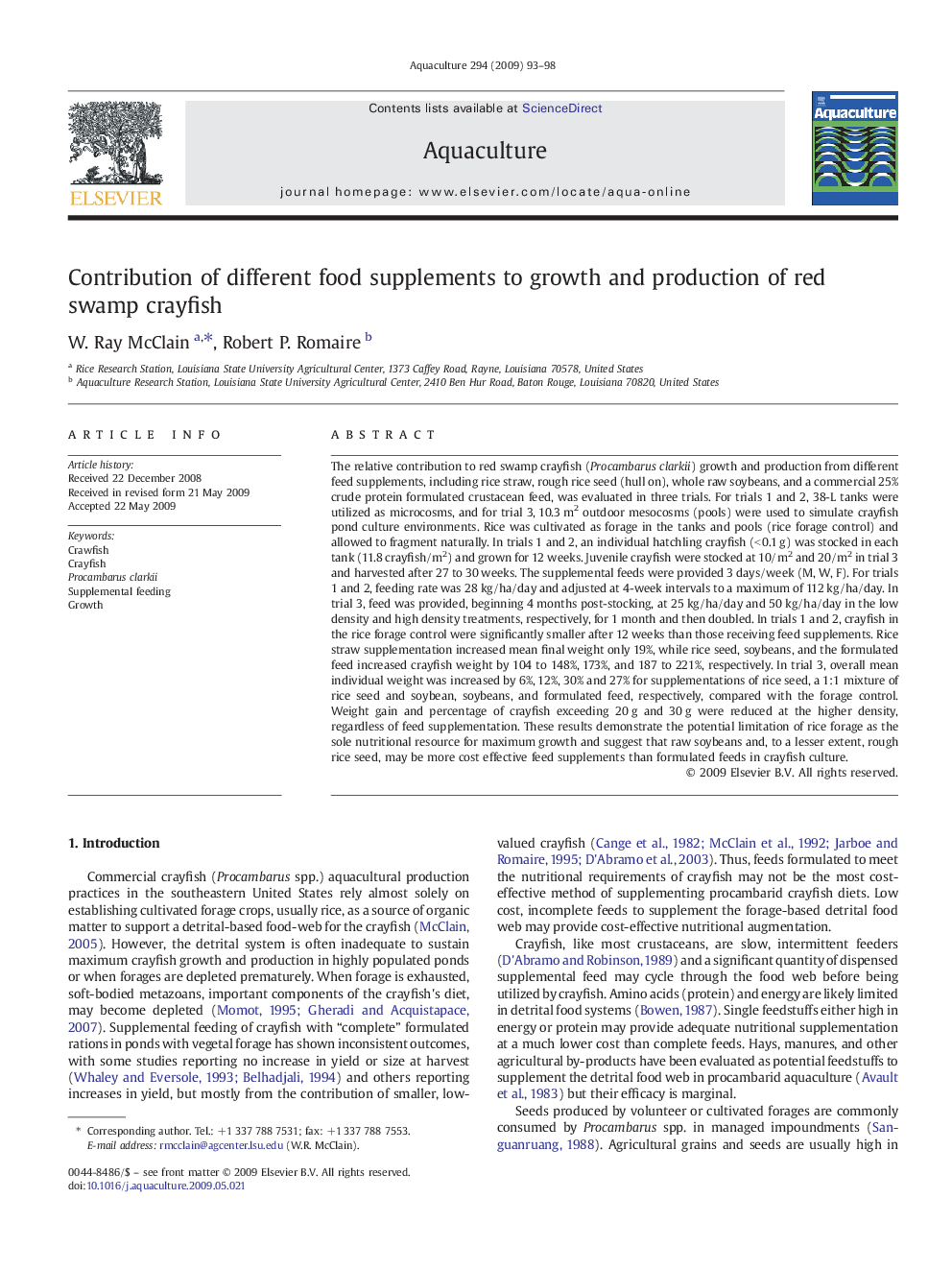| کد مقاله | کد نشریه | سال انتشار | مقاله انگلیسی | نسخه تمام متن |
|---|---|---|---|---|
| 8496118 | 1552939 | 2009 | 6 صفحه PDF | دانلود رایگان |
عنوان انگلیسی مقاله ISI
Contribution of different food supplements to growth and production of red swamp crayfish
دانلود مقاله + سفارش ترجمه
دانلود مقاله ISI انگلیسی
رایگان برای ایرانیان
کلمات کلیدی
موضوعات مرتبط
علوم زیستی و بیوفناوری
علوم کشاورزی و بیولوژیک
علوم آبزیان
پیش نمایش صفحه اول مقاله

چکیده انگلیسی
The relative contribution to red swamp crayfish (Procambarus clarkii) growth and production from different feed supplements, including rice straw, rough rice seed (hull on), whole raw soybeans, and a commercial 25% crude protein formulated crustacean feed, was evaluated in three trials. For trials 1 and 2, 38-L tanks were utilized as microcosms, and for trial 3, 10.3Â m2 outdoor mesocosms (pools) were used to simulate crayfish pond culture environments. Rice was cultivated as forage in the tanks and pools (rice forage control) and allowed to fragment naturally. In trials 1 and 2, an individual hatchling crayfish (<Â 0.1Â g) was stocked in each tank (11.8Â crayfish/m2) and grown for 12Â weeks. Juvenile crayfish were stocked at 10/m2 and 20/m2 in trial 3 and harvested after 27 to 30Â weeks. The supplemental feeds were provided 3Â days/week (M, W, F). For trials 1 and 2, feeding rate was 28Â kg/ha/day and adjusted at 4-week intervals to a maximum of 112Â kg/ha/day. In trial 3, feed was provided, beginning 4Â months post-stocking, at 25Â kg/ha/day and 50Â kg/ha/day in the low density and high density treatments, respectively, for 1Â month and then doubled. In trials 1 and 2, crayfish in the rice forage control were significantly smaller after 12Â weeks than those receiving feed supplements. Rice straw supplementation increased mean final weight only 19%, while rice seed, soybeans, and the formulated feed increased crayfish weight by 104 to 148%, 173%, and 187 to 221%, respectively. In trial 3, overall mean individual weight was increased by 6%, 12%, 30% and 27% for supplementations of rice seed, a 1:1 mixture of rice seed and soybean, soybeans, and formulated feed, respectively, compared with the forage control. Weight gain and percentage of crayfish exceeding 20Â g and 30Â g were reduced at the higher density, regardless of feed supplementation. These results demonstrate the potential limitation of rice forage as the sole nutritional resource for maximum growth and suggest that raw soybeans and, to a lesser extent, rough rice seed, may be more cost effective feed supplements than formulated feeds in crayfish culture.
ناشر
Database: Elsevier - ScienceDirect (ساینس دایرکت)
Journal: Aquaculture - Volume 294, Issues 1â2, 1 September 2009, Pages 93-98
Journal: Aquaculture - Volume 294, Issues 1â2, 1 September 2009, Pages 93-98
نویسندگان
W. Ray McClain, Robert P. Romaire,